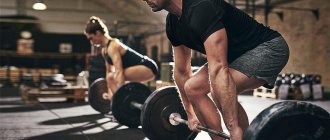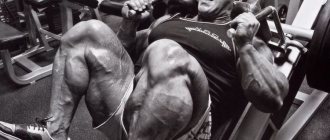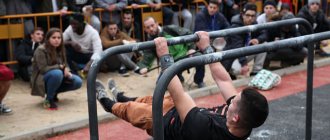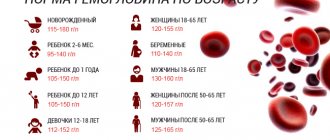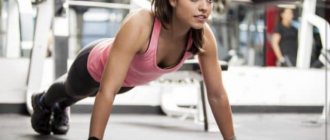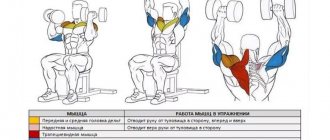In fact, split training is a classic approach to bodybuilding training. Please note that the majority of gym goers (the male half) exercise precisely according to this scheme, and this scheme is a training process that is divided into certain muscle groups and laid out for a certain period of time - a week, for example. Yes, this method is not the best option for beginner athletes. Before split training, it is better to focus on training the whole body and not break it down into muscle groups for at least a month.
What is split training
Split training is a way to create a highly effective program in which 2-3 muscle groups are worked out in one session. Moreover, in this mode there is an opportunity for complete rest and the best recovery. So, for example, if we consider the classic triple split, which is essentially a division of the body into three parts, which are worked out on different days during the week.
With such training, each group has the opportunity to recover for a week. For example, if an athlete does legs on Monday, then the next time he will train legs on Monday. Also, with this training strategy, you can successfully alternate, add and combine exercises or experiment with combining muscle groups.
Frequency of classes
For most girls, going to the gym 3 times a week is enough. The program is designed so that training days alternate with rest. If desired, on rest days you can do swimming, yoga or cardio exercises.
If you can’t structure your week so that there is rest between classes, you can do 2 days in a row, but then one workout should be more difficult and the other easier. Also, you should not do split training 3 days in a row. This load is too serious and is only suitable for professional athletes.
Benefits of a split program
According to scientists and sports doctors, muscle hypertrophy is a long-term process. On average, the growth of muscle fibers after a single intense load continues for two or even three weeks. In this case, training designed to work all muscle groups in one workout actually inhibits the development of skeletal muscles and, naturally, reduces the effectiveness of training. By the way, such training will quickly lead to exhaustion of the body. The athlete’s body will spend all its energy on recovery, the growth phase will not start.
Split training allows you to efficiently work out specific muscle groups during a workout and recover effectively during the allotted time for rest, that is, until the next workout. Split training is best for gaining muscle mass.
Nutritional Features
When split training, as with any other, it is necessary to follow the principles of a healthy diet and use healthy foods as a source of energy. Of course, under the influence of the load, the muscles will become stronger, regardless of your nutrition. But excessive consumption of sweet, fried and fast food will make these changes insignificant and poorly noticeable. The nutrition program is adjusted depending on the goals of the training, as well as the time of training. If your goal is to lose weight, you need to be especially careful. In this case, it is necessary to reduce the caloric content of the diet and maintain the correct proportions of fats, proteins and carbohydrates. Compliance with the principles of proper nutrition is especially important for girls, as their body accumulates fat deposits faster and takes longer to build muscle tissue. A proper nutrition program and regular exercise help adjust your metabolism and set your body up for the desired changes. We must not forget the importance of water. On training days, your rate increases. If you usually drink 2 liters of water per day, you will need approximately 2.5 liters during exercise.
Who is suitable for split training?
Split training is suitable for athletes who have a certain athletic level, when training for all muscle groups becomes insufficiently effective. Split training is also perfect for bodybuilders who deeply work each muscle using different training methods and a whole range of exercises. But this type of training should not be recommended for beginners until the body has adapted to physical activity. And the amount of load that split training provides is also useless for beginners or athletes after a long break in training.
How to start training girls in the gym correctly
First you need to choose a good gym that has the entire sports arsenal. The gym should be well-groomed and clean, and the coaching staff should be experienced and responsive. You must take drinking water and a towel with you. The differences between women's training and men's are minimal, but they are worth knowing about. Below I will list them and briefly talk about them.
Weight weight and number of repetitions
A considerable part of the coaching staff prepares training programs for girls, which are aimed, to put it mildly, at shaking the air. They include long-term work on all kinds of exercise bikes, treadmills, ellipsoids, steppers, etc. These trainers also like to prescribe high-repetition exercises with light dumbbells or bodyweight. The number of repetitions reaches 30, so to speak, fictitious work on a drawn relief. I repeat once again: only a calorie deficit together with effective training and good recovery will help to achieve relief, regardless of a person’s gender.
It has been proven that training for both girls and men should take place with relatively heavy weights. But this does not mean that in the first training you need to immediately lift heavy weights and overstrain your fragile body. To begin with, novice athletes need their bodies to get stronger and get used to physical activity. The number of repetitions should vary depending on your goals:
- 1-5 times – development of strength indicators;
- 6-12 - increase in muscle mass and volume;
- 12+ - increased stamina.
The weight of the weights should be selected in such a way that the last repetitions are difficult for you. Many girls think that if they lift heavy weights, they will turn into masculine monsters with a mountain of muscles. I want to assure you on the shore that this is not so. as much as 16 times less than in men This fact does not apply to women who have resorted to the use of anabolic steroids (I strongly do not recommend it).
Training schemes
There are two training schemes:
- “Fullbody” (from the English “full body” - whole body) is a scheme that is aimed at working out the whole body in one training day. In simple words: in one workout you work the muscles of the chest, back, legs, arms, abs, etc. This scheme is recommended for use by beginners and athletes after a long break. After all, it helps the muscles gradually get used to grueling loads;
- Split training is a method in which one or two muscle groups are worked out in one training day. This method allows you to load the target muscle groups as efficiently as possible. After all, you can perform more exercises per muscle group, unlike the “fullbody” scheme. Split training is intended for experienced athletes and athletes.
I recommend girls to train using the full body system. Such training allows the female body to develop harmoniously and actively burn extra calories.
Training frequency
Many girls mistakenly think that daily workouts will help them quickly achieve an ideal body. Dear and beautiful ladies, I want to assure you that more often does not mean better. The muscles and central nervous system strictly need rest. After all, without quality restoration you will not achieve results. The optimal number of workouts is 3 times a week with breaks between them of 1-2 days.
Cardio training
Cardio training is an aerobic exercise that is designed to speed up metabolism due to the active work of the heart muscle and lungs. Cardio exercise is aimed at strengthening the cardiovascular system, improving endurance and losing weight.
Types of cardio:
- Run;
- Walking;
- Skis;
- Swimming
- Cycling;
- Jumping rope, etc.
The training program for girls must include cardio. Add it to the beginning of your workout as a warm-up. For example, 10-15 minutes of slow running to warm up the body and at the end of the workout to cool down. Start walking more in your daily life.
The right approach to split training
- You need to start with training for all muscle groups. You need to practice in this mode for at least one to two months. During this period, training is a set of basic exercises and linear cycling of training is used. It is divided into 4 stages, but we will not dwell on this, since this is a separate large topic.
- After this phase, the training process can be transferred to a two-day split training. This phase can last from several months to six months. Basically, basic exercises are used at this stage.
- The next stage will be a three-day split. This program is a classic of sorts. By the way, another feature of split training is the alternation of different exercises and muscle groups in the first and second weeks. This prevents the body from getting used to the load and adapting to the exercises, which makes the training more effective.
- In addition to the three-day split, there is also a four-day and a five-day split. Such options allow you to further increase the load and work out specific muscle groups more effectively. With such training, the number of approaches and exercises for each muscle group increases. Typically, four and five day splits are used by professional athletes or athletes using hormonal anabolic drugs. The training uses both basic and isolation exercises. Athletes of average training level do not need this type of training at all and will not give the desired result.
- It is also worth adding that in split training mode, you can work out either synergist muscles, for example: pectoral muscles, anterior deltoid and triceps, or antagonists - chest and back muscles, biceps and triceps in one session. Read more about antagonist and synergist muscles →
- High-level athletes can split their leg workouts into quads and soleus, and then hamstrings and calves.
Recommendations for different body types
Read more about this classification in a separate material on somatotypes.
Ectomorph
Thin people with thin bones, underdeveloped muscle corset and low subcutaneous body fat:
- Nutrition . To gain weight, you need a high-calorie diet (more than 3300 kcal/day). The basis of the menu should be “complex” carbohydrates: cereals, durum wheat pasta, whole grain bread. Proteins and fats should be consumed in approximately equal proportions. You need to eat several times a day. If you can’t increase your body weight, you can use sports nutrition: creatine, gainers.
- Physical exercise . For ectomorphs, it is not advisable to get involved in aerobic training. Classes should be based on basic elements (deadlift, bench press, squat). Exercises should be distributed over 3 sessions per week, that is, the preferred type of training for the ectomorphic type is a three-day split with pauses of 1-2 days.
Mesomorph
Physically developed, strong people, most predisposed to strength training:
- Nutrition . The basis of a mesomorph’s diet should be protein foods: red meat, poultry, fish, cottage cheese. Menu calorie content: 3200–3400 kcal/day. People with a mesomorphic body type need to reduce carbohydrates and fats in their diet. Recommended supplements: vitamins, protein mixtures.
- Physical exercise . The basis of mesomorph training is the same strength elements: squats, bench presses, deadlifts. Exercises should be divided into 3 sessions. At the same time, a three-day split training for men should be strength training, that is, in each approach you need to select the weight so that failure is felt at 7-8 repetitions. In addition to the basic elements, you should select “complementary” exercises that promote maximum blood supply to the muscles. Rest between classes - 1-2 days.
Endomorph
Large-boned people with a high percentage of subcutaneous fat and weak, undeveloped muscles:
- Nutrition . The diet should be divided into small portions. Low calorie content: no more than 1800 kcal/day. The basis of the menu should be lean proteins (chicken fillet, eggs without yolks, fish, low-fat cottage cheese) and vegetable fiber (fruits, vegetables, herbs). The amount of carbohydrate food should be reduced to 15% of the daily value. Recommended supplements: vitamins, fat-burning complexes, high-quality protein isolates.
- Physical exercise . The training program should be drawn up for three days a week. It is recommended that these classes be carried out in an aerobic mode, aimed at burning fat and tightening the body (for example, aerobics, circuit training). If an athlete wants to train using the split method, the weights should be selected so that the approaches are multi-repetitive (15–20 times). The break between classes is 1 day. During recovery periods, you can do cardio exercises outside (for example, cycling or a light jog in the park).
As a rule, mixed body types predominate among people, for example, ectomorph-mesomorph. To more accurately determine your body type and create an effective training program, we recommend contacting a professional fitness trainer.
Main part
To begin with, here are the general principles of doing the exercises.
- To tone muscles and maintain shape for each part of the body, it is enough to do 3-4 exercises of 12-15 repetitions in 3 sets. Choose a medium weight to feel the load. Rest between sets is 40–60 seconds, and between exercises – 1.5 minutes.
- For girls who are working on body definition and losing weight, it is recommended to work with small weights with a higher number of repetitions (15–20, in some exercises can be increased to 20–25). In this case, the pace should be kept slightly above average, and the rest between exercises should be reduced if possible.
- When working on mass, on the contrary, you need to increase the working weight to close to the maximum (for beginners to slightly above average), reducing the number of repetitions to 8–12. You should rest 60–90 seconds between sets and 2.5 minutes when changing exercises.
Whatever your training goals, proper technique plays a huge role. Improper execution of movements is not only ineffective, but also dangerous, especially when working with weights. The cycle phase is important in girls’ training. At the beginning of the month, you can increase the load, try new exercises and devote more time to aerobic exercise. In the second half of the cycle, it is worth giving the body a rest from intense exercise and, if you feel unwell, reduce weight or reduce repetitions.
